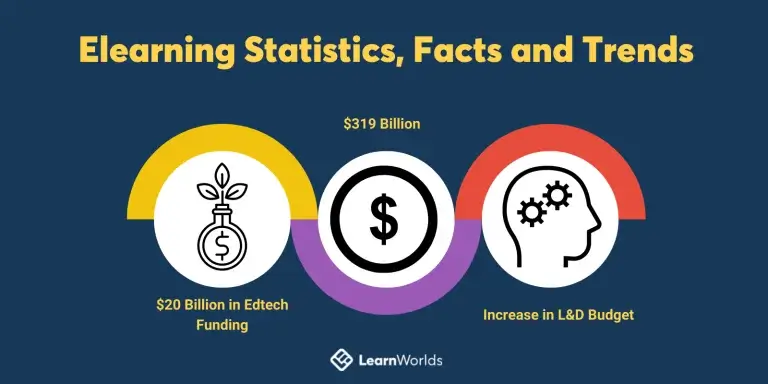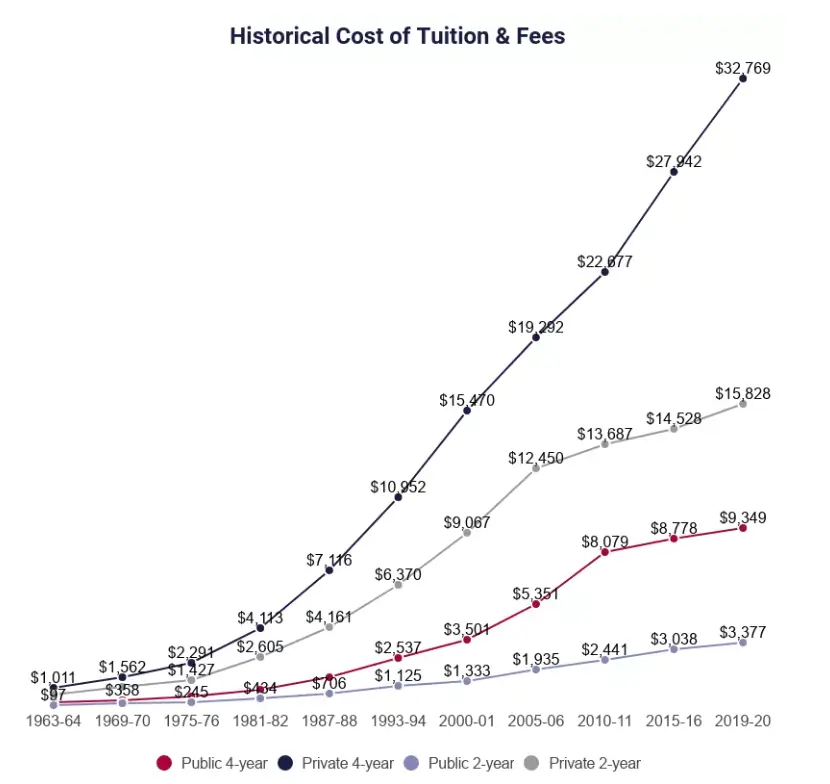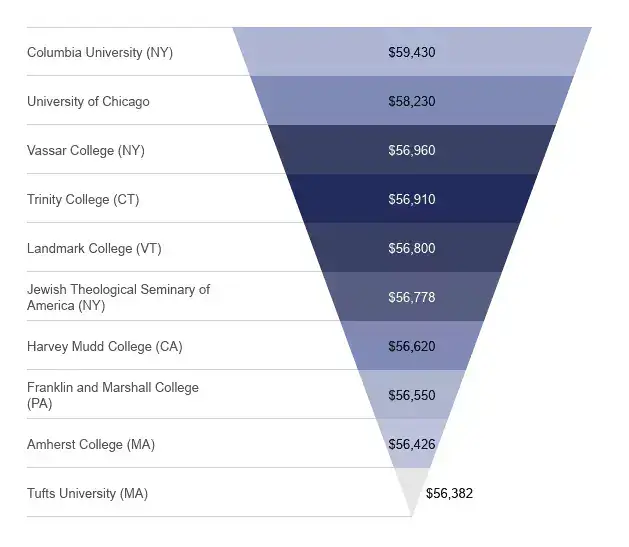Table of Contents
The elearning market has experienced a significant shift in recent times, with the growing need for flexible and accessible education. The demand for distance learning has been fueled by factors such as technological advancements, changing demographics, and the need for continuous learning.
The pandemic has accelerated this trend, but even prior to it, many educational institutions and businesses were already moving towards more flexible and remote learning solutions. However, the pandemic has undoubtedly brought this issue to the forefront and has further increased the urgency of adapting to new models of education.
All these have given a boost to a growing elearning industry with the elearning market expected to reach $319 billion by 2029, $49 billion of which is forecasted to be the market share for elearning courses.
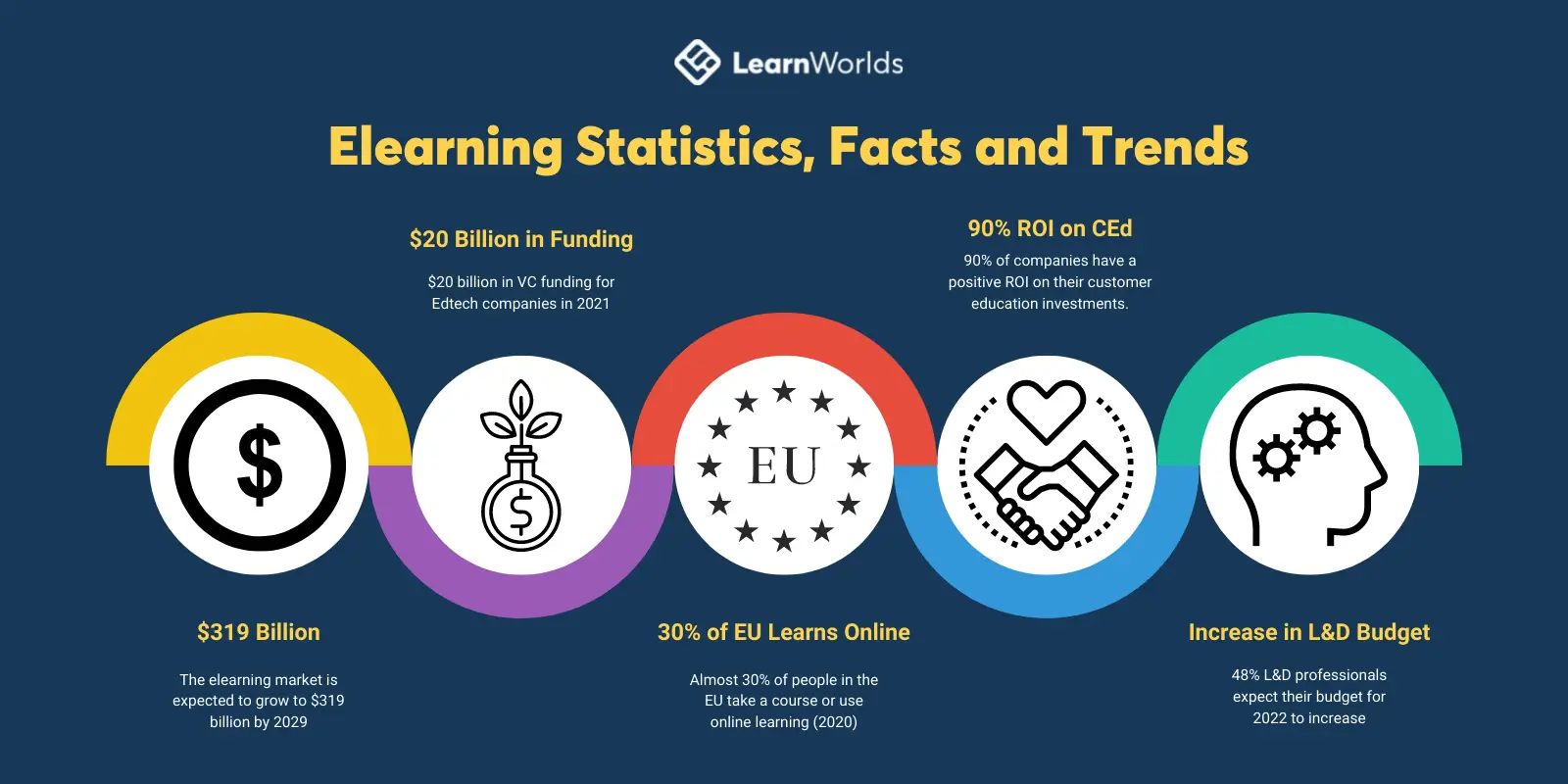
Currently, there is a lot of new information and is constantly updated given the state of the industry. While reviewing data ourselves, we have browsed through dozens of articles, surveys and publicly available data and compiled a list of current and relevant online learning statistics and facts.
Most data relate to the U.S. market as it remains the main market for elearning, whereas some data come from Europe.
Table of contents
- 1General Elearning Statistics
- 2eLearning Statistics for Business
- 3Corporate eLearning Statistics
- 4Customer Education Statistics
- 5Mobile Learning Statistics
- 6General Elearning Facts for Public Schools & K12 Statistics
- 6Higher Education (College) Statistics
- 7Elearning Environmental impact
- 8Elearning Funding & Startups
General Elearning Statistics
Since the early 2000s, the online learning market has been growing, with recent events increasing the growth rate exponentially.
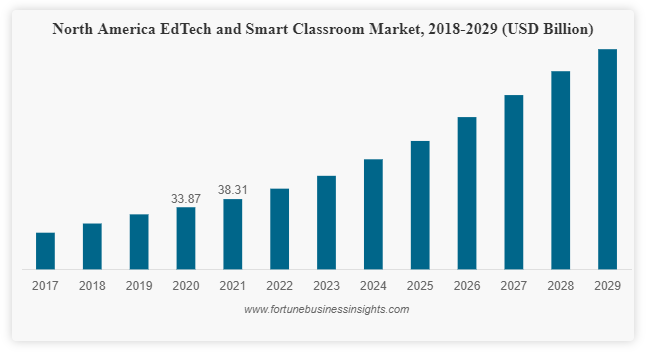
The global learning management system (LMS) market size was valued at USD 14.43 billion in 2021, and is expected to grow to 40.95 billion by 2029 with a CAGR of 14.2%. Source: Fortune Business Insights
Almost 30% of people in the EU are taking an online course or using digital learning material.
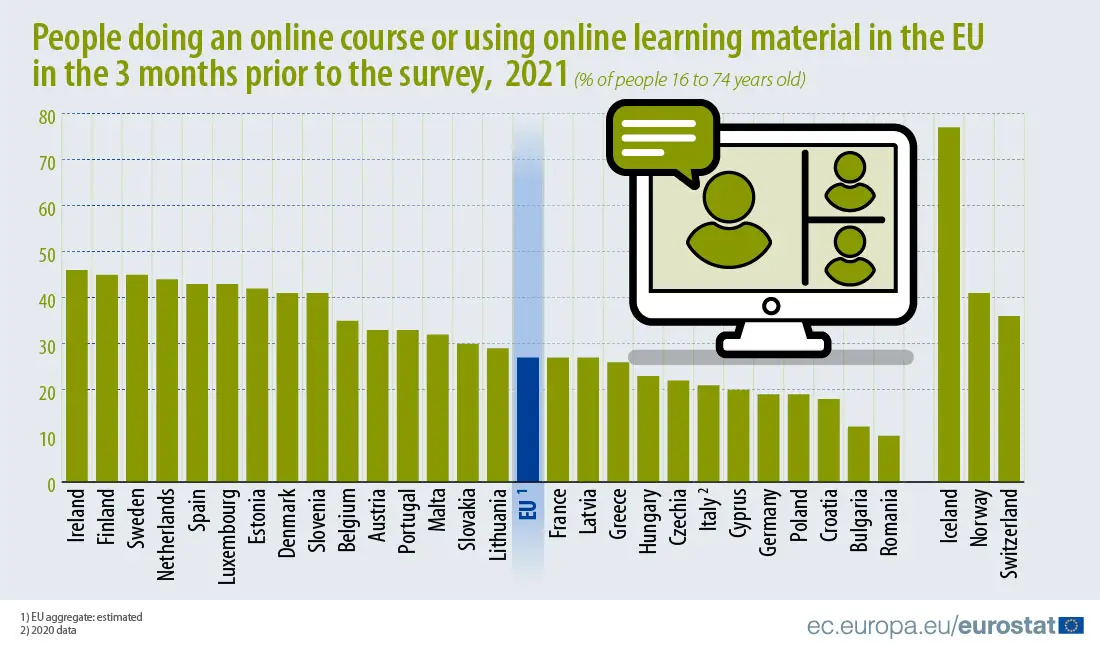
Roles & Salaries (Averages)
Elearning jobs are on the rise, with new positions being created to cover the needs for designing learning material for educational institutions and corporate training in enterprises.
Here are the average salaries of various elearning positions taken from Glassdoor:
eLearning Statistics for Business
Online training, reskilling, and upskilling are essential for any modern business. Most industries are undergoing major changes, making skills or positions that were relevant a few years ago outdated and in need of revision.
Companies find it cheaper to update the skills of current employees or retrain them for other positions over going through an expensive hiring and onboarding process.
Learning & Development
Companies expect to increase their L&D investment and evolve their programs in 2023. While budgets might be affected -with the current economic climate and a possibility for a recession in after-pandemic times-, L&D will probably continue changing and evolving to adapt into the new status quo.
Training Priorities
Learning and development initiatives take up a huge responsibility in digital transformation and reskilling the employees. LinkedIn Learning’s survey reveals the top priorities of companies for L&D programs and L&D leaders in 2023:
Adult Learning in Europe (EU)
Europe is a diverse collection of countries working together, but at different “speeds.” However, adult learning and corporate learning in the whole European economic area seems to be important for many businesses.
The following information comes from Eurostat public data.
Corporate eLearning Statistics
It costs more to hire a new employee or lose an existing one over training and reskilling a current one. The Work Institute says that the cost of employee turnover is $20,000, while the cost of employee reskilling is under $10,000.
Employee training, upskilling & reskilling
Many surveys focus on the topic of employee turnover -as well as the ongoing economic trend known as the Great Resignation– and how to tackle it with reskilling or upskilling, as it’s a problem faced even by the Fortune 500 companies:
Challenges
Many companies face challenges in retaining the best talent, and they believe education, skills, and growth can help. Even so, measuring the impact of learning in top business KPIs is still a tricky business.
69% of companies say that an inability to measure learning’s impact represents a challenge to achieving critical learning outcomes (Source: 2019 Brandon Hall Group Learning Measurement Study).
22.2% of employees leave companies due to career development reasons. One of the main reasons is lack of Growth & Development Opportunities, with an increase of 170% from 2010 to 2018 as the reason for leaving (Source: Work Institute)
As the skill gap is growing and L&D becomes more important, as per LinkedIn Learning’s survey:
Customer Education Statistics
Businesses do not only care about employee training, but also about customer education (CEd). We witness a rise in learning trends regarding customer education, where CEd programs can act as part of the marketing funnel to increase retention rates as well as:
In some cases, CEd programs can also generate revenue for companies.
570% Return on Investment (ROI) of customer training. For every dollar spent, companies in the Intellum Forrester study earned $6.7, translating to 6.2% of top-line revenue. Intellum Forrester Study on October 2019
Formalized customer education programs in 2019:
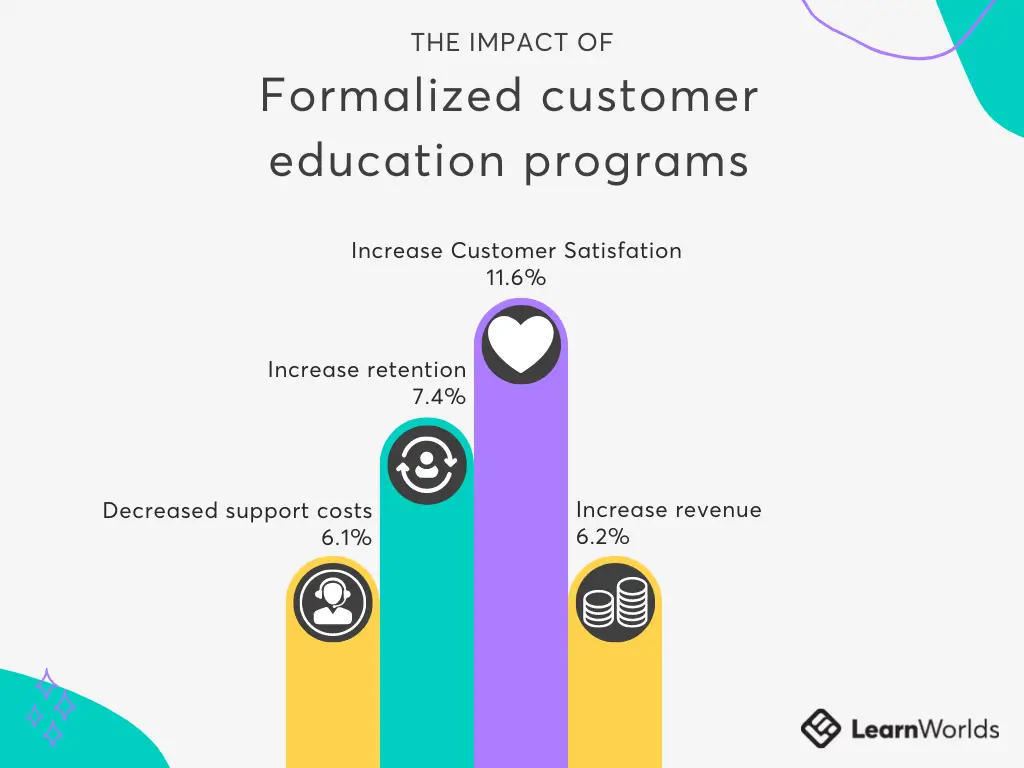
Educational Content
Research by Conductor.com shows that consumers that engage with educational content are more likely to purchase from brands. More specifically:
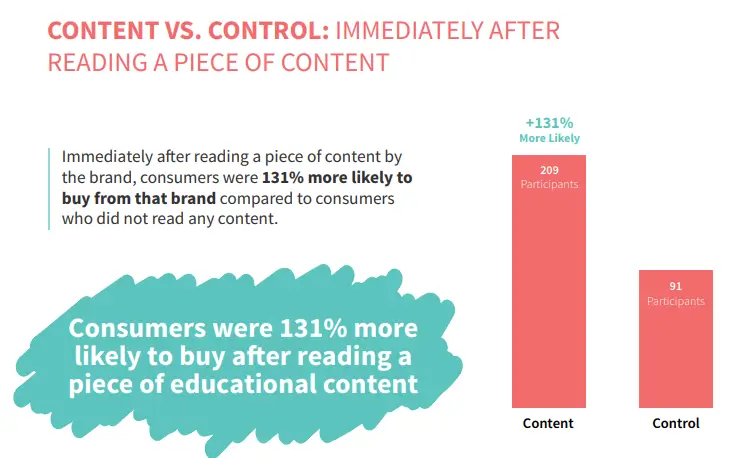
Who carries out Customer Education?
Customer Education (CEd) programs take many forms. While many companies choose to have an in-house team and a platform such as a massive open online course (MOOC) -a way to deliver open learning content online to anyone interested- or a Learning Management System (LMS), others outsource the training program development or even the whole process to outside parties like an agency or a vendor.
This information was taken by Forrester Study on October 2019. The study splits execution to results, where high and low success organizations are split.
HS = High Success Organizations
LS = Low Success Organizations
Mobile Learning Statistics
The number of mobile learners and the use of smartphones is on the rise. Mobile users are expected to grow from 7.1 billion in 2021 to 7.49 billion in 2025 (Statista).
Mobile devices are now considered part of the classroom experience and come with both challenges and opportunities for learning.
56% of teachers and principals say that their districts/schools provide at least one device per student. EdWeek Survey, June 2020
About two thirds of educators believe the number and type of devices available today has positively impacted teaching. EdWeek Survey, June 2020
64% of students have used smartphones for instructional purposes. EdWeek Survey, June 2020
Here is the breakdown:
Top 10 ways K12 students used smartphones for instructional purposes:
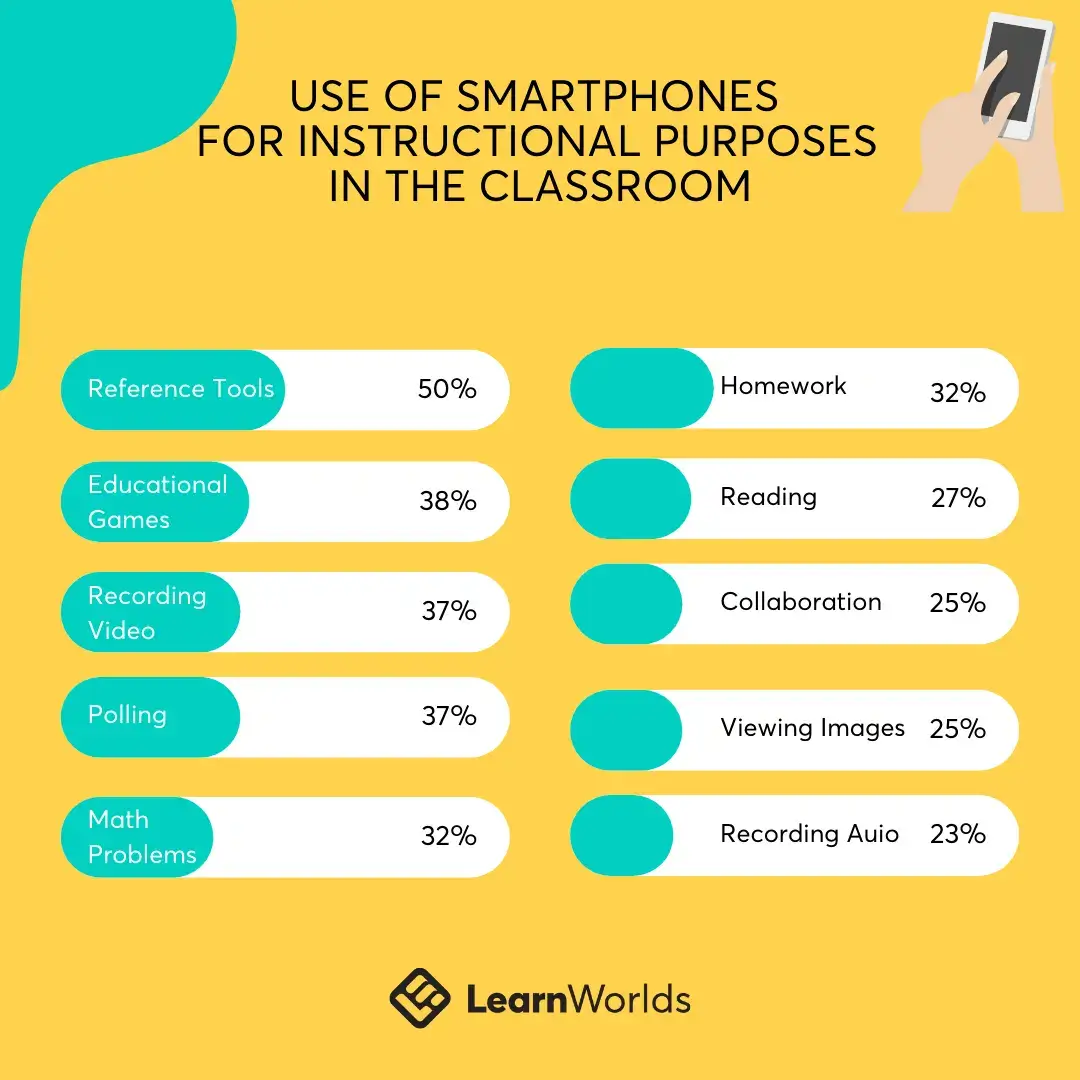
General eLearning Facts for Public Schools & K12 Statistics
The U.S. Department of Commerce reports 95% of children in the U.S. have access to the internet either through a computer or smartphone (American Community Survey, 2019).
The survey goes into more details for schools:
How technology affects student learning opportunities
Educators and schools responded to a survey on public schools in 2020:
Opportunities for Virtual Instruction
Edweek’s Technology in Teaching and Learning Survey asks school principals and district directors to identify virtual instruction opportunities for students at no cost. Below are the top 3:
Challenges of eLearning
Continuing with NCES’ public school survey for 2020, it seems that teachers are not sufficiently trained in how to use technology:
65% (almost two thirds) of schools find the lack of time as the main factor for not being able to get teachers to become familiar with new technologies and use them for teaching.
Other challenges for technology adoption in the classroom are:
While K12 educators identify a different set of challenges:
Teacher statistics on Gender & Salary
According to the U.S. Department of Education, there is a discrepancy in the gender of teachers. Teachers in 2017-2018 for K12 are primarily female:
The numbers change in elementary school, where more female teachers are found:
And, in secondary education the gap lessens:
Average teacher salary in the U.S. varies from $42,000 to $70,500 depending on experience, location and other factors. (Source: National Center for Education Statistics)
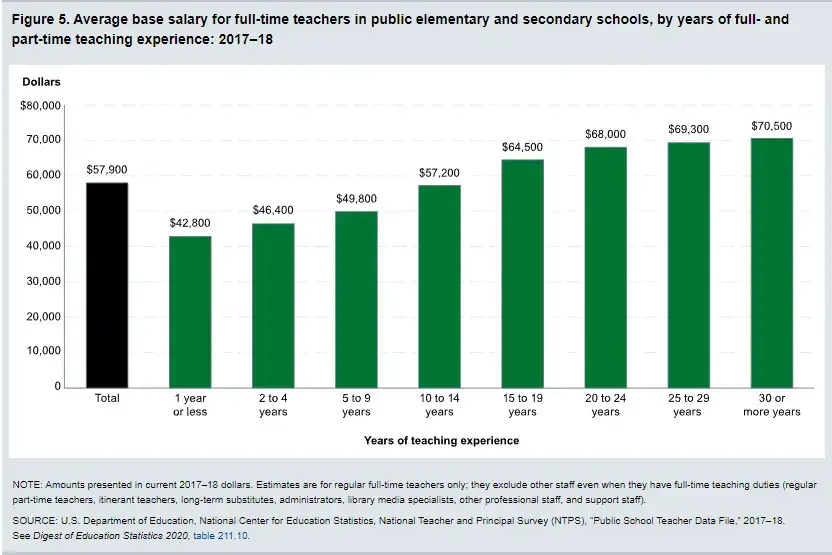
In-person vs Virtual/Remote learning
Edweek’s survey continues with scarring remarks from K12 educators and leaders. The survey included 460 teachers, 165 principals (or school leaders) & 263 district leaders.
The results coming against virtual and remote learning:
Higher Education (College) Statistics
The pandemic’s effect on traditional learning methods has pushed universities to adapt and rethink the traditional classroom, compare the benefits and tackle the challenges of elearning.
General College Statistics
College enrollment (U.S.) totaled 15.9 million undergraduate students nationwide in fall 2020. College Enrollment & Student Demographic Statistics
Below are more statistics on college education in the U.S. by Educationdata.org:
50.8% of all bachelor’s degrees are in 5 fields:
Cost of Online Education vs. Traditional Education
With so many learners moving online, how does physical college education compare with online degrees and which costs are associated with them? (Source: Cost of Online Education vs Traditional Education)
Average Costs of University
The cost of a 4-year degree has skyrocketed over the past decades, with tuition costs and fees at an all-time high, signaling a rise in revenue for higher education institutions.
The average in-state student attending a public 4-year institution spends $25,487 for one academic year.
The average traditional private university student spends a total of $53,217 per academic year, $35,807 of it on tuition and fees.
The average cost of attendance for a student living on campus at a public 4-year in-state institution is $25,487 per year or $101,948 over 4 years.
Top 10 Most Expensive Private Colleges in the U.S.
Searches for “college online admission form” grow globally year over year by over 100%. Source: ThinkWithGoogle
The below chart from Google Trends shows a quadrupling of searches for elearning which continues until today at 3 times more searches over the pre-pandemic levels.
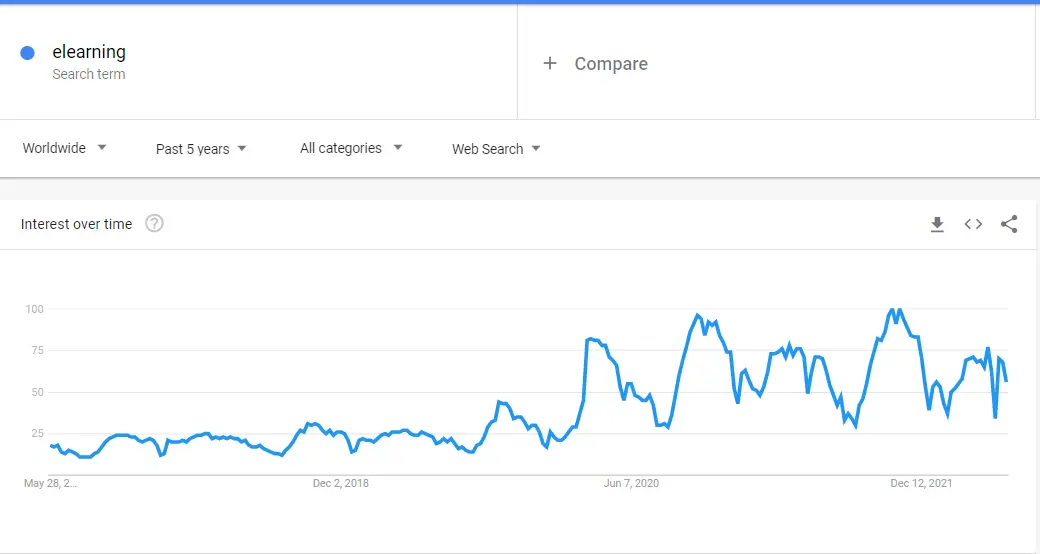
Elearning Environmental impact
Many early papers expected the rise of elearning to contribute to the green revolution. However, information and research in the topic seems to be outdated, partially as it is difficult to trace and calculate the impact of such a direct industry.
Online learning platforms were welcomed by environmentalists as solutions to the car-infested colleges and expected that elearning platforms would take-over a physical industry. This is still unproven by a large degree.
Here are some of the early papers:
Reduced by 5-10 tons per semester per 100 students who currently commute to university. Source: University of California Paper
Potential to reduce up to 89% of CO2 emissions. Source
Elearning Funding & Startups
In many ways, elearning is a trend in itself, and one that only continues to grow. In 2021, Edtech startups raised $20B in VC funding globally, that’s 1.3x more than the 2020 total.
Mega rounds were the main driver of edtech funding, which accounted for 62%. $100M+ rounds are becoming more frequent and big population centers like India and China may see even more unicorns in the following years as new companies compete for market share.
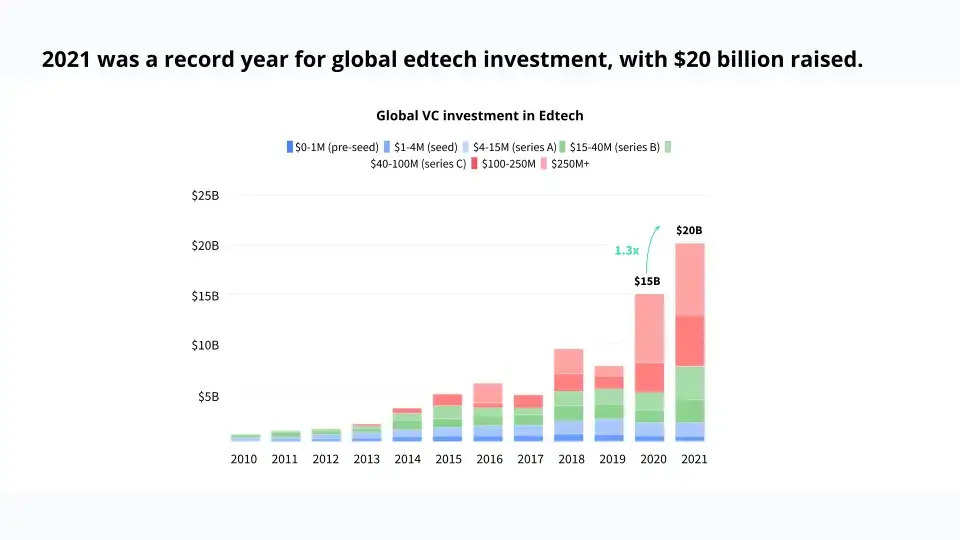
India and China are leading the recent unicorn valuations with Tutoring startups, but as we can see on the table below, the variety of edtech funded startups is big. We could expect more niche startups to show up and become unicorns in the next few years in niches like: microlearning, gamification, mobile apps, and course platforms focused on the learning experience (LXP).
Top 10 EdTech Unicorns
| Company | Country | Type | Latest Funding Round | Valuation |
|---|---|---|---|---|
| ByJu’s | India | Tutoring | $800M | $22B |
| Yuanfudao | China | Tutoring | $300M | $15.5B |
| Zuoyebang | China | Tutoring | $1.6B | $10B |
| BetterUp | U.S. | Corporate | $300M | $4.7B |
| Learning | ||||
| VIPKid | China | Language | $150M | $4.5B |
| Guild Education | US | Online Post Secondary/Employers | $150M | $3.8B |
| Articulate | US | Corporate Learning | $1.5B | $3.75B |
| Course Hero | US | Study Notes | $380M | $3.6B |
| Handshake | US | Career Planning | $200M | $3.5B |
| GoStudent | Austria | Tutoring | $340M | $3.4B |
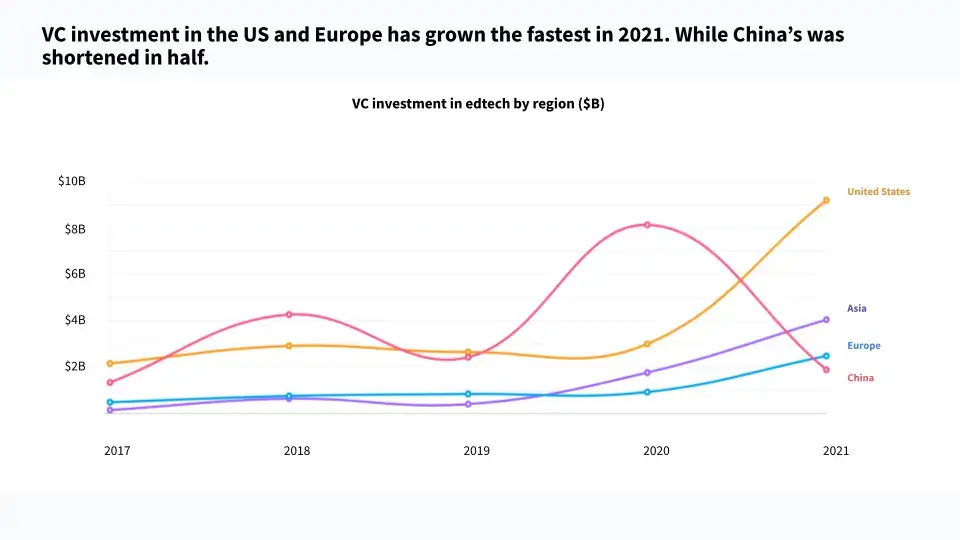
Investment into European Edtech startups has more than doubled in the last year, making the region one of the fastest-growing globally. Although rounds up to $40M lead the European funding landscape, late-stage investments are increasing their share of capital.
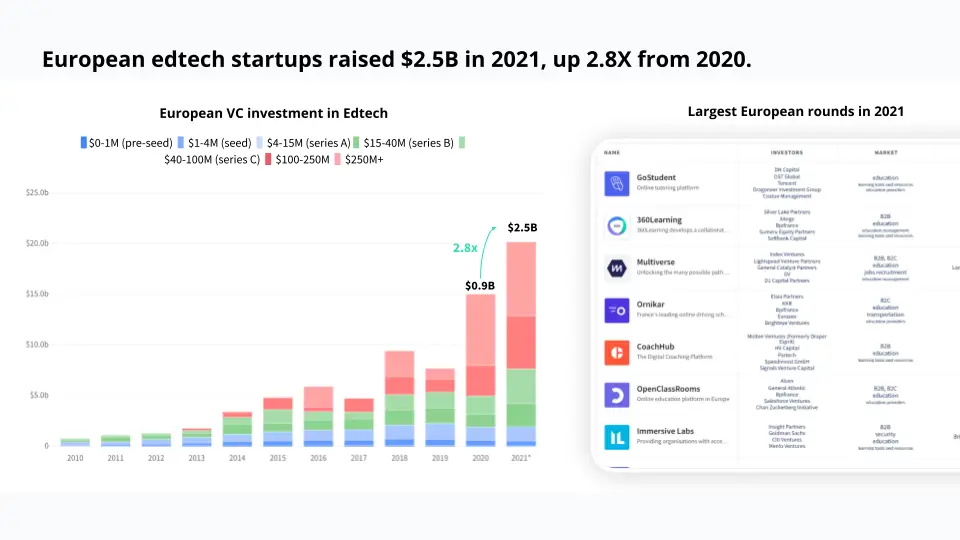
Online Education is Growing!
The rise of Massive Open Online Courses (MOOCs) with platforms such as Udemy, EdX & Coursera are giving place to software solutions that allow entrepreneurs and SMEs to launch their own course like LearnWorlds, while elearning has also become more accessible (and more a need) to a wide range of businesses.
The global market is looking for better solutions to tackle modern problems, and turns to education to accomplish higher revenues through producing educational resources.
As the global population increases, more and more students are seeking education, schooling, and tutoring options, particularly in high-population countries.
Mobile devices, increased internet accessibility, and new technologies in education do not constitute new elearning trends, but a need for more accessible and better education to a mass audience.
Lastly, the pandemic has accelerated the online courses industry, and the effect is expected to grow, with more digital learning tools to create and sell online courses.
Nick Malekos is a Senior Digital Marketer in LearnWorlds. He is a results based and well-rounded Digital Marketer with years of experience in the education industry, writer and digital literacy trainer.

